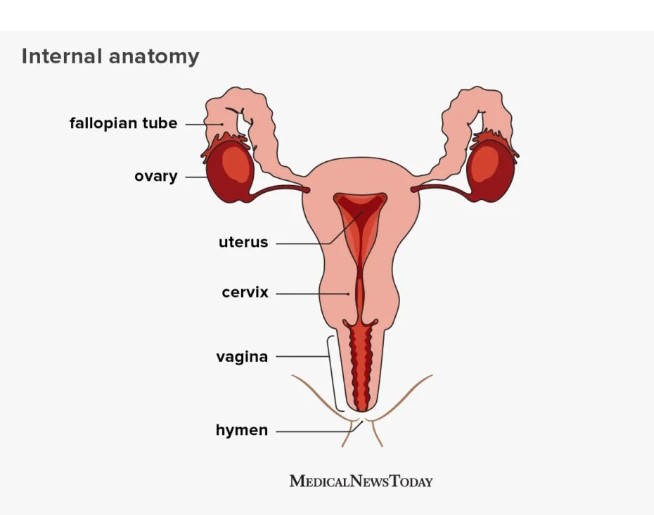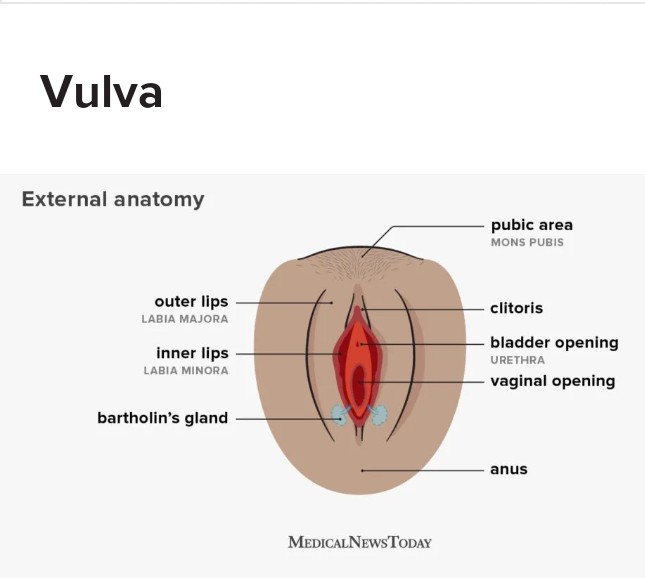
Designed by Diego Sebogal
By Mary West (MNT)
Overview
Ovaries
Fallopian tubes
Uterus
Cervix and vagina
Clitoris
Vulva
Summary
The female reproductive organs include several key structures, such as the ovaries, uterus, vagina, and vulva. These organs are involved in fertility, conception, pregnancy, and childbirth.
The reproductive organs also have a significant influence on other aspects of health. For example, the ovaries create hormones that impact bone density, cholesterol levels, heart health, and mood.
In this article, we will look at the anatomy of the female reproductive organs in detail, including what they do and how they work.
Sex and gender exist on spectrums. This article will use the terms “male,” “female,” or both to refer to sex assigned at birth.
What is the female reproductive system?

Design by Diego Sabogal
The female reproductive system is a group of organs that work together to enable reproduction, pregnancy, and childbirth. It also produces female sex hormones, including estrogen and progesterone.
The system consists of organs and tissues inside the body and some that are visible outside the body. The internal organs include:
ovaries
fallopian tubes
uterus
cervix
vagina
Another organ, the clitoris, extends both inside and outside the body. The external area surrounding the vagina is the vulva.
Not everyone who is assigned female at birth has all of these organs. Sometimes, people are born without some parts or with a mixture of female and male characteristics. This is known as intersex.
Some people also undergo procedures to remove some parts of the reproductive system. Some of these procedures take place for medical reasons, while others are the result of harmful cultural practices, such as female genital mutilation.
Ovaries
Most females have two ovaries, one on each side of the uterus. They are about the shape and size of an almond and have two key functions: producing hormones and releasing eggs.
At birth, two ovaries contain approximately 700,000 oocytes, which are immature eggs. When a person reaches puberty, these eggs begin to develop and mature inside the ovary follicles. Around once each month, the ovaries release a mature egg.
This process is known as ovulation, and it is part of the menstrual cycle. It is also what makes pregnancy possible.
The hormones the ovaries produce regulate the menstrual cycle. They also:
influence the development of female sex traits
facilitate pregnancy, childbirth, and breast milk production
contribute to the health of the bones, heart, liver, brain, and other tissues
influence mood, sleep, and sex drive
Fallopian tubes
The fallopian tubes are passageways that carry eggs toward the uterus. They consist of several parts:
the infundibulum, which is a funnel-shaped opening near the ovaries
the fimbriae, which are finger-like projections surrounding the opening
cilia, which are hair-like structures inside the fallopian tubes
When an ovary releases an egg, fluid and the fimbriae propel it toward the fallopian tube opening. Once inside, the cilia move the egg toward the uterus. This journey takes about 7 days.
During this time, it is possible for sperm to fertilize the egg if a person has sexual intercourse. Most fertilization happens in the fallopian tubes.
Uterus
The uterus is an organ that is about the shape and size of a pear. It is also known as the womb. It consists of muscular walls and a lining (endometrium) that grows and diminishes with each menstrual cycle.
After ovulation, the endometrium gets thicker in preparation for a fertilized egg. If not fertilized, the egg dies, and the lining of the womb sheds after around 2 weeks. The lining breaks down into blood, which then leaves the body through the vagina. This is menstruation, also called a period.
If an egg does become fertilized by sperm, it will implant into the lining of the uterus and begin to develop. The cells divide and grow, becoming an embryo. Over time, it grows into a fetus, which receives oxygen and nutrients from the placenta via the umbilical cord.
When it is time for the fetus to be born, the uterus begins strong muscle contractions that dilate the cervix and push the fetus out.
Cervix and vagina
The cervix is a narrow structure at the bottom of the uterus. It has several functions:
Producing mucus: The cervix produces cervical mucus, which stops sperm from entering the uterus when a person is not fertile or when they are pregnant.
Protecting against bacteria: The mucus also stops bacteria from entering the uterus and keeps the vagina healthy.
Allowing fluids to drain: At the bottom of the cervix is a small opening that allows fluids, such as menstrual blood, to pass through.
Below the cervix is the vagina, which is a flexible, tubular structure that connects the internal and external reproductive organs. It sits behind the bladder and in front of the digestive tract.
The vagina allows fluids, such as menstrual blood and discharge, to leave the body. It also allows semen, which contains sperm, to enter the body.
This can happen in several ways, such as during penetrative sex with someone who has a penis, or during artificial insemination. This is a procedure where a doctor inserts semen into the uterus to help someone conceive.
Clitoris
Just inside the body, around the entrance to the vagina, is the clitoris. This organ is most well known for the clitoral glans, which is a small but highly sensitive tissue that sits above the vaginal opening. Most of the clitoris is actually internal.
The clitoral glans is at the top of the clitoris. From there, the clitoris splits into two parts that extend down either side of the vagina. It is around 5 inches (12.7 centimeters) long and consists of spongy tissue that contains thousands of nerve endings.
The clitoris responds to sexual stimulation. When a person experiences arousal, it becomes swollen. It is the main organ responsible for female orgasms.
Vulva

Design by Diego Sabogal
The vulva is the external part of the female reproductive system. It includes the:
Vestibule: This is the entrance to the vagina. Around the vestibule sit the greater vestibular glands, which produce fluid to keep the area from getting dry. During sexual arousal, these glands produce more fluid to help with lubrication.
Hymen: Some people with vulvas also have a hymen. This is a thin, delicate tissue that partially covers the entrance to the vagina. When someone has penetrative sex for the first time, the hymen can stretch or break. But not everyone has a hymen, and it can also stretch for a number of other reasons.
Urethra: This is where urine comes from. The urethra is part of the urinary system and sits just above the vaginal opening.
Labia minora: These are smaller lips that surround the entrance to the vagina.
Clitoral hood and glans: The clitoral hood is a small piece of tissue that protects the external part of the clitoris. It sits at the top of the labia minora.
Labia majora: These are the larger lips that surround the vulva. After puberty, they typically have pubic hair. At the top of the vulva is also the mons pubis, which is a rounded pad of fat that sits over the pubic bone.
Summary
The female reproductive organs include an array of parts that influence health throughout a person’s life. The reproductive system undergoes significant changes during the menstrual cycle, which starts during puberty and ends with menopause. If a person becomes pregnant, it changes further to accommodate a growing fetus.
Female reproductive anatomy also influences sexual well-being, and creates hormones that regulate a wide variety of functions around the body.







